JEEP PATRIOT 2019 Owner handbook (in English)
Manufacturer: JEEP, Model Year: 2019, Model line: PATRIOT, Model: JEEP PATRIOT 2019Pages: 332, PDF Size: 1.99 MB
Page 31 of 332
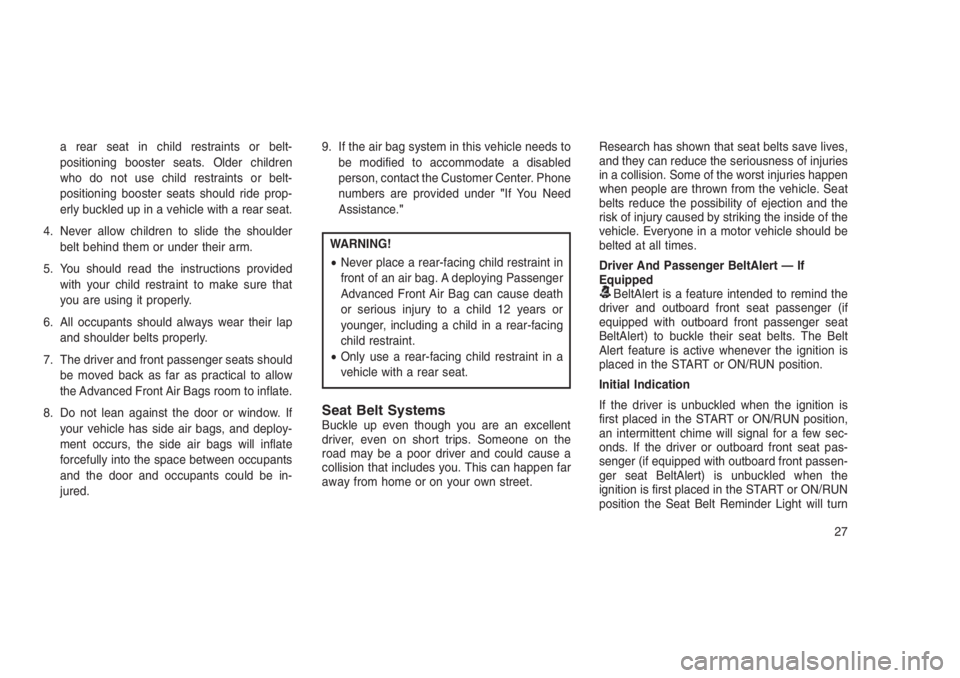
a rear seat in child restraints or belt-
positioning booster seats. Older children
who do not use child restraints or belt-
positioning booster seats should ride prop-
erly buckled up in a vehicle with a rear seat.
4. Never allow children to slide the shoulder
belt behind them or under their arm.
5. You should read the instructions provided
with your child restraint to make sure that
you are using it properly.
6. All occupants should always wear their lap
and shoulder belts properly.
7. The driver and front passenger seats should
be moved back as far as practical to allow
the Advanced Front Air Bags room to inflate.
8. Do not lean against the door or window. If
your vehicle has side air bags, and deploy-
ment occurs, the side air bags will inflate
forcefully into the space between occupants
and the door and occupants could be in-
jured.9. If the air bag system in this vehicle needs to
be modified to accommodate a disabled
person, contact the Customer Center. Phone
numbers are provided under"If You Need
Assistance."
WARNING!
•Never place a rear-facing child restraint in
front of an air bag. A deploying Passenger
Advanced Front Air Bag can cause death
or serious injury to a child 12 years or
younger, including a child in a rear-facing
child restraint.
•Only use a rear-facing child restraint in a
vehicle with a rear seat.
Seat Belt SystemsBuckle up even though you are an excellent
driver, even on short trips. Someone on the
road may be a poor driver and could cause a
collision that includes you. This can happen far
away from home or on your own street.Research has shown that seat belts save lives,
and they can reduce the seriousness of injuries
in a collision. Some of the worst injuries happen
when people are thrown from the vehicle. Seat
belts reduce the possibility of ejection and the
risk of injury caused by striking the inside of the
vehicle. Everyone in a motor vehicle should be
belted at all times.
Driver And Passenger BeltAlert — If
Equipped
BeltAlert is a feature intended to remind the
driver and outboard front seat passenger (if
equipped with outboard front passenger seat
BeltAlert) to buckle their seat belts. The Belt
Alert feature is active whenever the ignition is
placed in the START or ON/RUN position.
Initial Indication
If the driver is unbuckled when the ignition is
first placed in the START or ON/RUN position,
an intermittent chime will signal for a few sec-
onds. If the driver or outboard front seat pas-
senger (if equipped with outboard front passen-
ger seat BeltAlert) is unbuckled when the
ignition is first placed in the START or ON/RUN
position the Seat Belt Reminder Light will turn
27
Page 32 of 332
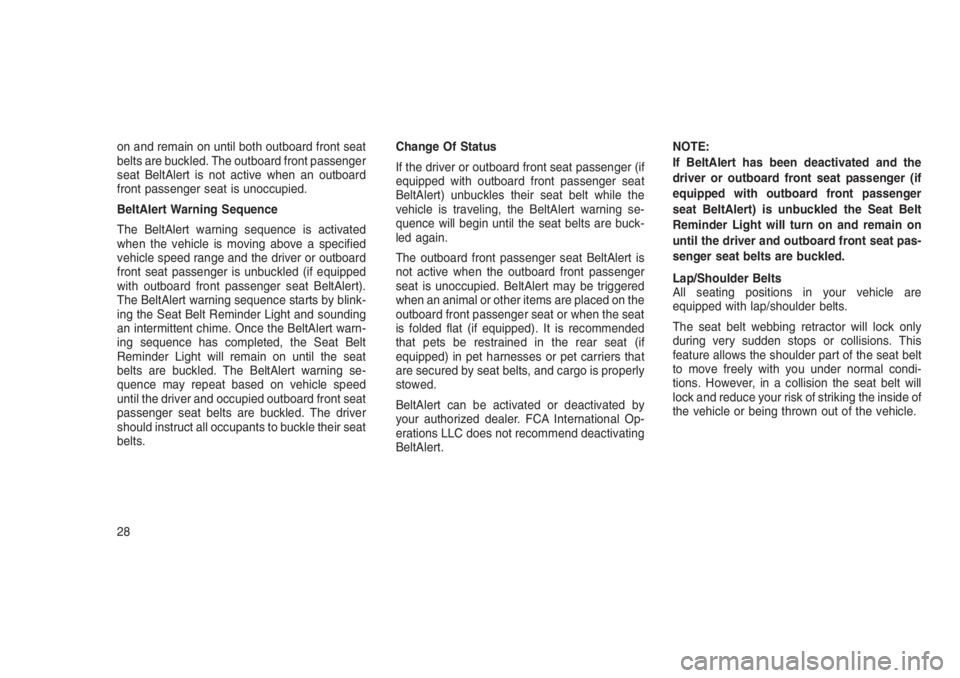
on and remain on until both outboard front seat
belts are buckled. The outboard front passenger
seat BeltAlert is not active when an outboard
front passenger seat is unoccupied.
BeltAlert Warning Sequence
The BeltAlert warning sequence is activated
when the vehicle is moving above a specified
vehicle speed range and the driver or outboard
front seat passenger is unbuckled (if equipped
with outboard front passenger seat BeltAlert).
The BeltAlert warning sequence starts by blink-
ing the Seat Belt Reminder Light and sounding
an intermittent chime. Once the BeltAlert warn-
ing sequence has completed, the Seat Belt
Reminder Light will remain on until the seat
belts are buckled. The BeltAlert warning se-
quence may repeat based on vehicle speed
until the driver and occupied outboard front seat
passenger seat belts are buckled. The driver
should instruct all occupants to buckle their seat
belts.Change Of Status
If the driver or outboard front seat passenger (if
equipped with outboard front passenger seat
BeltAlert) unbuckles their seat belt while the
vehicle is traveling, the BeltAlert warning se-
quence will begin until the seat belts are buck-
led again.
The outboard front passenger seat BeltAlert is
not active when the outboard front passenger
seat is unoccupied. BeltAlert may be triggered
when an animal or other items are placed on the
outboard front passenger seat or when the seat
is folded flat (if equipped). It is recommended
that pets be restrained in the rear seat (if
equipped) in pet harnesses or pet carriers that
are secured by seat belts, and cargo is properly
stowed.
BeltAlert can be activated or deactivated by
your authorized dealer. FCA International Op-
erations LLC does not recommend deactivating
BeltAlert.NOTE:
If BeltAlert has been deactivated and the
driver or outboard front seat passenger (if
equipped with outboard front passenger
seat BeltAlert) is unbuckled the Seat Belt
Reminder Light will turn on and remain on
until the driver and outboard front seat pas-
senger seat belts are buckled.
Lap/Shoulder Belts
All seating positions in your vehicle are
equipped with lap/shoulder belts.
The seat belt webbing retractor will lock only
during very sudden stops or collisions. This
feature allows the shoulder part of the seat belt
to move freely with you under normal condi-
tions. However, in a collision the seat belt will
lock and reduce your risk of striking the inside of
the vehicle or being thrown out of the vehicle.
28
Page 33 of 332
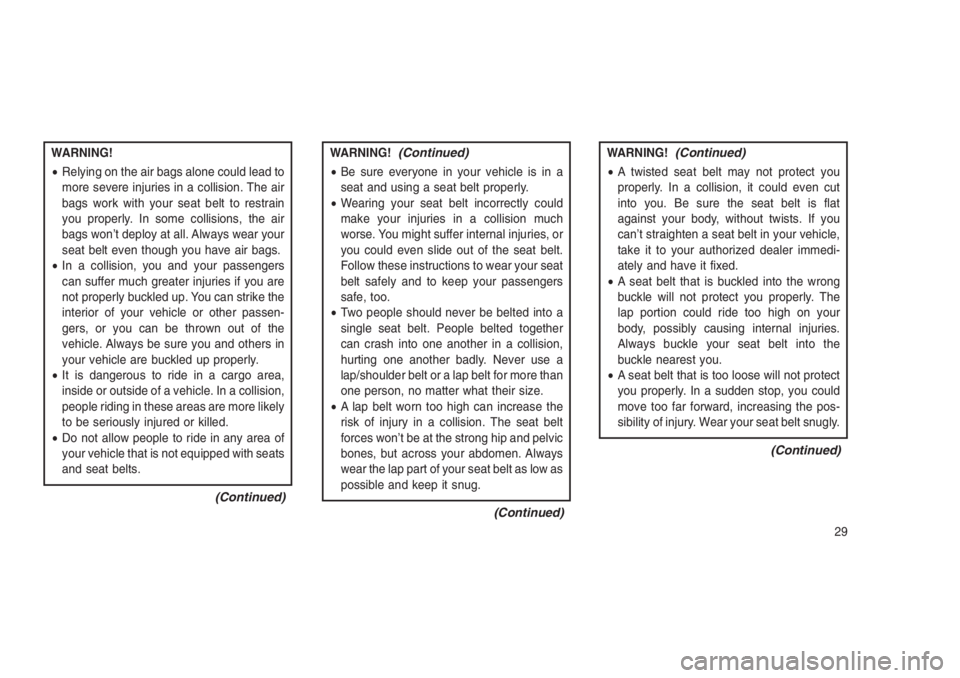
WARNING!
•Relying on the air bags alone could lead to
more severe injuries in a collision. The air
bags work with your seat belt to restrain
you properly. In some collisions, the air
bags won’t deploy at all. Always wear your
seat belt even though you have air bags.
•In a collision, you and your passengers
can suffer much greater injuries if you are
not properly buckled up. You can strike the
interior of your vehicle or other passen-
gers, or you can be thrown out of the
vehicle. Always be sure you and others in
your vehicle are buckled up properly.
•It is dangerous to ride in a cargo area,
inside or outside of a vehicle. In a collision,
people riding in these areas are more likely
to be seriously injured or killed.
•Do not allow people to ride in any area of
your vehicle that is not equipped with seats
and seat belts.
(Continued)
WARNING!(Continued)
•Be sure everyone in your vehicle is in a
seat and using a seat belt properly.
•Wearing your seat belt incorrectly could
make your injuries in a collision much
worse. You might suffer internal injuries, or
you could even slide out of the seat belt.
Follow these instructions to wear your seat
belt safely and to keep your passengers
safe, too.
•Two people should never be belted into a
single seat belt. People belted together
can crash into one another in a collision,
hurting one another badly. Never use a
lap/shoulder belt or a lap belt for more than
one person, no matter what their size.
•A lap belt worn too high can increase the
risk of injury in a collision. The seat belt
forces won’t be at the strong hip and pelvic
bones, but across your abdomen. Always
wear the lap part of your seat belt as low as
possible and keep it snug.
(Continued)
WARNING!(Continued)
•A twisted seat belt may not protect you
properly. In a collision, it could even cut
into you. Be sure the seat belt is flat
against your body, without twists. If you
can’t straighten a seat belt in your vehicle,
take it to your authorized dealer immedi-
ately and have it fixed.
•A seat belt that is buckled into the wrong
buckle will not protect you properly. The
lap portion could ride too high on your
body, possibly causing internal injuries.
Always buckle your seat belt into the
buckle nearest you.
•A seat belt that is too loose will not protect
you properly. In a sudden stop, you could
move too far forward, increasing the pos-
sibility of injury. Wear your seat belt snugly.
(Continued)
29
Page 34 of 332
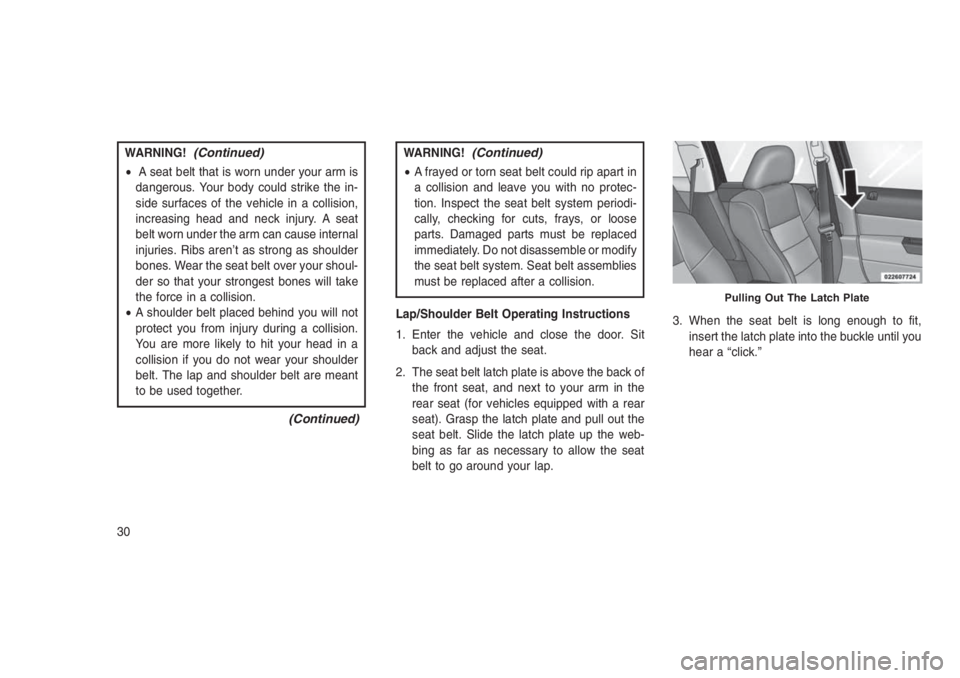
WARNING!(Continued)
•A seat belt that is worn under your arm is
dangerous. Your body could strike the in-
side surfaces of the vehicle in a collision,
increasing head and neck injury. A seat
belt worn under the arm can cause internal
injuries. Ribs aren’t as strong as shoulder
bones. Wear the seat belt over your shoul-
der so that your strongest bones will take
the force in a collision.
•A shoulder belt placed behind you will not
protect you from injury during a collision.
You are more likely to hit your head in a
collision if you do not wear your shoulder
belt. The lap and shoulder belt are meant
to be used together.
(Continued)
WARNING!(Continued)
•A frayed or torn seat belt could rip apart in
a collision and leave you with no protec-
tion. Inspect the seat belt system periodi-
cally, checking for cuts, frays, or loose
parts. Damaged parts must be replaced
immediately. Do not disassemble or modify
the seat belt system. Seat belt assemblies
must be replaced after a collision.
Lap/Shoulder Belt Operating Instructions
1. Enter the vehicle and close the door. Sit
back and adjust the seat.
2. The seat belt latch plate is above the back of
the front seat, and next to your arm in the
rear seat (for vehicles equipped with a rear
seat). Grasp the latch plate and pull out the
seat belt. Slide the latch plate up the web-
bing as far as necessary to allow the seat
belt to go around your lap.3. When the seat belt is long enough to fit,
insert the latch plate into the buckle until you
hear a “click.”
Pulling Out The Latch Plate
30
Page 35 of 332
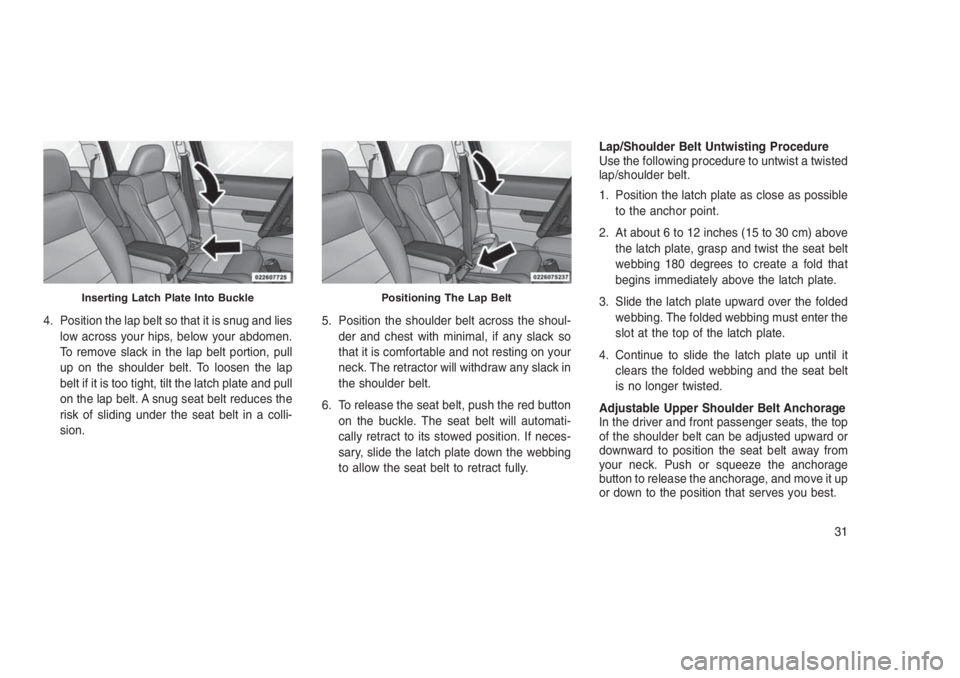
4. Position the lap belt so that it is snug and lies
low across your hips, below your abdomen.
To remove slack in the lap belt portion, pull
up on the shoulder belt. To loosen the lap
belt if it is too tight, tilt the latch plate and pull
on the lap belt. A snug seat belt reduces the
risk of sliding under the seat belt in a colli-
sion.5. Position the shoulder belt across the shoul-
der and chest with minimal, if any slack so
that it is comfortable and not resting on your
neck. The retractor will withdraw any slack in
the shoulder belt.
6. To release the seat belt, push the red button
on the buckle. The seat belt will automati-
cally retract to its stowed position. If neces-
sary, slide the latch plate down the webbing
to allow the seat belt to retract fully.Lap/Shoulder Belt Untwisting Procedure
Use the following procedure to untwist a twisted
lap/shoulder belt.
1. Position the latch plate as close as possible
to the anchor point.
2. At about 6 to 12 inches (15 to 30 cm) above
the latch plate, grasp and twist the seat belt
webbing 180 degrees to create a fold that
begins immediately above the latch plate.
3. Slide the latch plate upward over the folded
webbing. The folded webbing must enter the
slot at the top of the latch plate.
4. Continue to slide the latch plate up until it
clears the folded webbing and the seat belt
is no longer twisted.
Adjustable Upper Shoulder Belt Anchorage
In the driver and front passenger seats, the top
of the shoulder belt can be adjusted upward or
downward to position the seat belt away from
your neck. Push or squeeze the anchorage
button to release the anchorage, and move it up
or down to the position that serves you best.
Inserting Latch Plate Into BucklePositioning The Lap Belt
31
Page 36 of 332
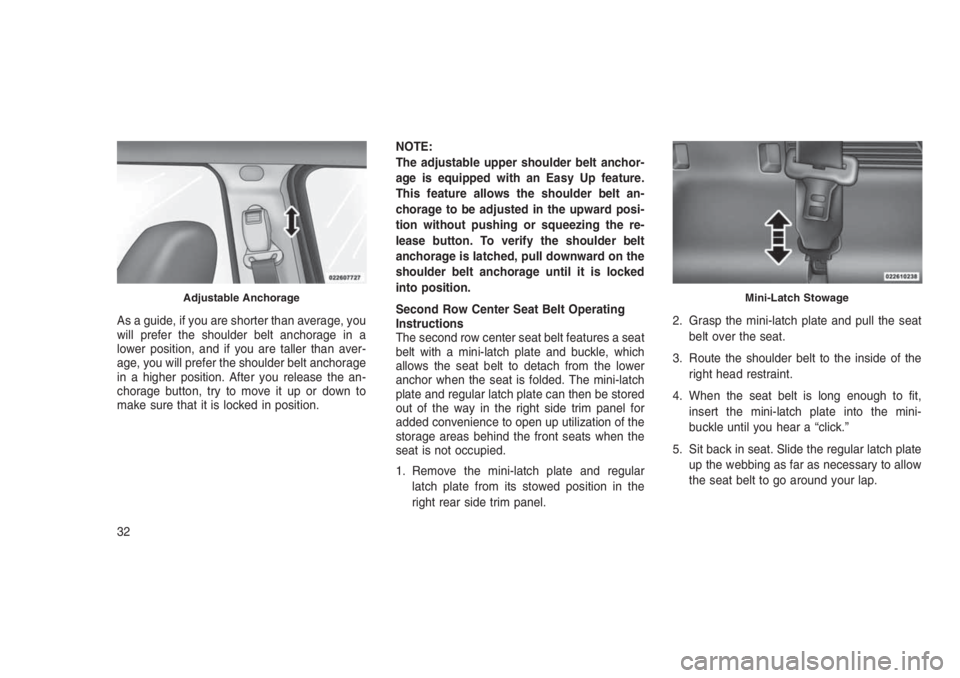
As a guide, if you are shorter than average, you
will prefer the shoulder belt anchorage in a
lower position, and if you are taller than aver-
age, you will prefer the shoulder belt anchorage
in a higher position. After you release the an-
chorage button, try to move it up or down to
make sure that it is locked in position.NOTE:
The adjustable upper shoulder belt anchor-
age is equipped with an Easy Up feature.
This feature allows the shoulder belt an-
chorage to be adjusted in the upward posi-
tion without pushing or squeezing the re-
lease button. To verify the shoulder belt
anchorage is latched, pull downward on the
shoulder belt anchorage until it is locked
into position.
Second Row Center Seat Belt Operating
Instructions
The second row center seat belt features a seat
belt with a mini-latch plate and buckle, which
allows the seat belt to detach from the lower
anchor when the seat is folded. The mini-latch
plate and regular latch plate can then be stored
out of the way in the right side trim panel for
added convenience to open up utilization of the
storage areas behind the front seats when the
seat is not occupied.
1. Remove the mini-latch plate and regular
latch plate from its stowed position in the
right rear side trim panel.2. Grasp the mini-latch plate and pull the seat
belt over the seat.
3. Route the shoulder belt to the inside of the
right head restraint.
4. When the seat belt is long enough to fit,
insert the mini-latch plate into the mini-
buckle until you hear a “click.”
5. Sit back in seat. Slide the regular latch plate
up the webbing as far as necessary to allow
the seat belt to go around your lap.
Adjustable AnchorageMini-Latch Stowage
32
Page 37 of 332
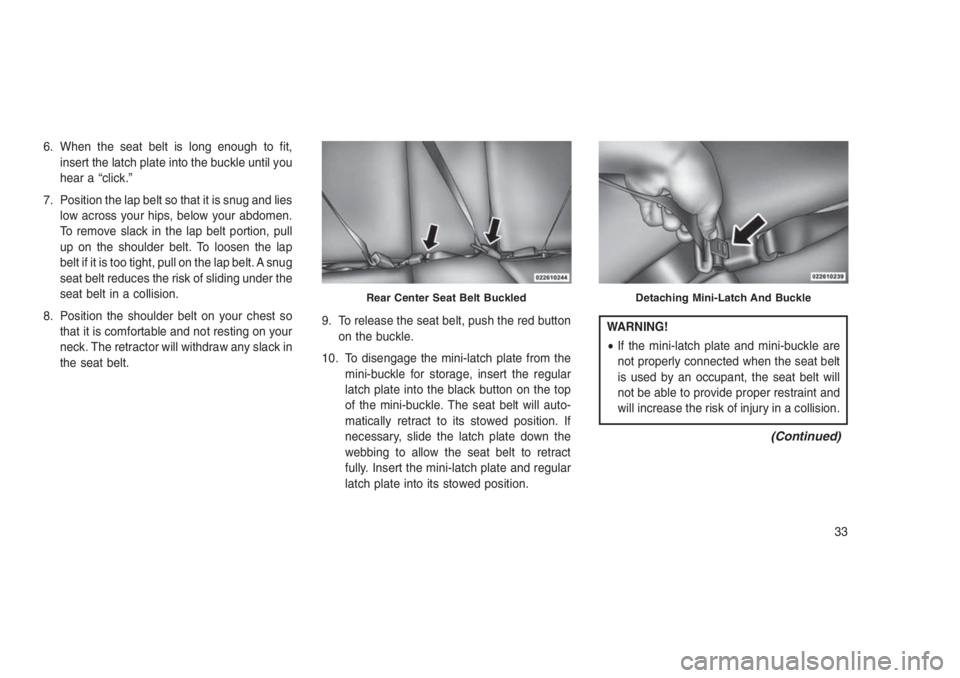
6. When the seat belt is long enough to fit,
insert the latch plate into the buckle until you
hear a “click.”
7. Position the lap belt so that it is snug and lies
low across your hips, below your abdomen.
To remove slack in the lap belt portion, pull
up on the shoulder belt. To loosen the lap
belt if it is too tight, pull on the lap belt. A snug
seat belt reduces the risk of sliding under the
seat belt in a collision.
8. Position the shoulder belt on your chest so
that it is comfortable and not resting on your
neck. The retractor will withdraw any slack in
the seat belt.9. To release the seat belt, push the red button
on the buckle.
10. To disengage the mini-latch plate from the
mini-buckle for storage, insert the regular
latch plate into the black button on the top
of the mini-buckle. The seat belt will auto-
matically retract to its stowed position. If
necessary, slide the latch plate down the
webbing to allow the seat belt to retract
fully. Insert the mini-latch plate and regular
latch plate into its stowed position.
WARNING!
•If the mini-latch plate and mini-buckle are
not properly connected when the seat belt
is used by an occupant, the seat belt will
not be able to provide proper restraint and
will increase the risk of injury in a collision.
(Continued)
Rear Center Seat Belt BuckledDetaching Mini-Latch And Buckle
33
Page 38 of 332
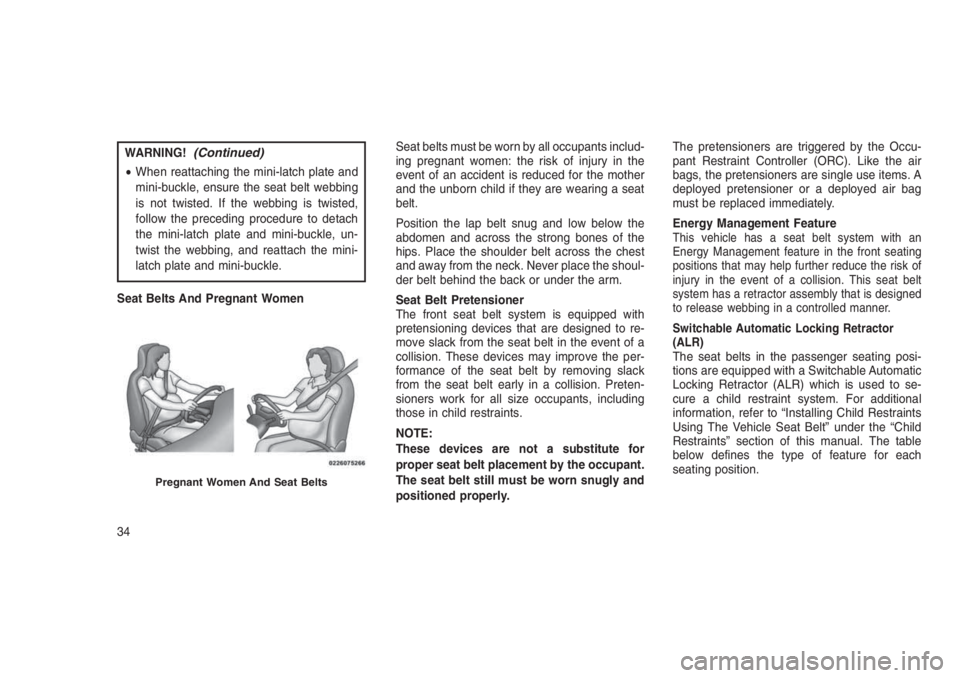
WARNING!(Continued)
•When reattaching the mini-latch plate and
mini-buckle, ensure the seat belt webbing
is not twisted. If the webbing is twisted,
follow the preceding procedure to detach
the mini-latch plate and mini-buckle, un-
twist the webbing, and reattach the mini-
latch plate and mini-buckle.
Seat Belts And Pregnant WomenSeat belts must be worn by all occupants includ-
ing pregnant women: the risk of injury in the
event of an accident is reduced for the mother
and the unborn child if they are wearing a seat
belt.
Position the lap belt snug and low below the
abdomen and across the strong bones of the
hips. Place the shoulder belt across the chest
and away from the neck. Never place the shoul-
der belt behind the back or under the arm.
Seat Belt Pretensioner
The front seat belt system is equipped with
pretensioning devices that are designed to re-
move slack from the seat belt in the event of a
collision. These devices may improve the per-
formance of the seat belt by removing slack
from the seat belt early in a collision. Preten-
sioners work for all size occupants, including
those in child restraints.
NOTE:
These devices are not a substitute for
proper seat belt placement by the occupant.
The seat belt still must be worn snugly and
positioned properly.The pretensioners are triggered by the Occu-
pant Restraint Controller (ORC). Like the air
bags, the pretensioners are single use items. A
deployed pretensioner or a deployed air bag
must be replaced immediately.
Energy Management Feature
This vehicle has a seat belt system with an
Energy Management feature in the front seating
positions that may help further reduce the risk of
injury in the event of a collision. This seat belt
system has a retractor assembly that is designed
to release webbing in a controlled manner.
Switchable Automatic Locking Retractor
(ALR)
The seat belts in the passenger seating posi-
tions are equipped with a Switchable Automatic
Locking Retractor (ALR) which is used to se-
cure a child restraint system. For additional
information, refer to “Installing Child Restraints
Using The Vehicle Seat Belt” under the “Child
Restraints” section of this manual. The table
below defines the type of feature for each
seating position.
Pregnant Women And Seat Belts
34
Page 39 of 332
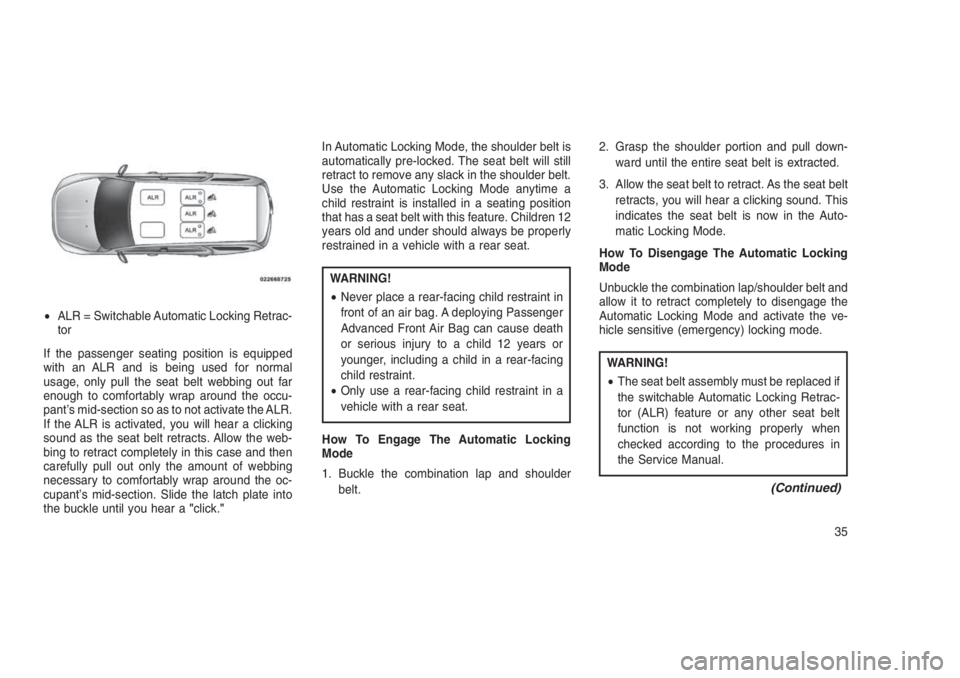
If the passenger seating position is equipped
with an ALR and is being used for normal
usage, only pull the seat belt webbing out far
enough to comfortably wrap around the occu-
pant’s mid-section so as to not activate the ALR.
If the ALR is activated, you will hear a clicking
sound as the seat belt retracts. Allow the web-
bing to retract completely in this case and then
carefully pull out only the amount of webbing
necessary to comfortably wrap around the oc-
cupant’s mid-section. Slide the latch plate into
the buckle until you hear a"click."In Automatic Locking Mode, the shoulder belt is
automatically pre-locked. The seat belt will still
retract to remove any slack in the shoulder belt.
Use the Automatic Locking Mode anytime a
child restraint is installed in a seating position
that has a seat belt with this feature. Children 12
years old and under should always be properly
restrained in a vehicle with a rear seat.
WARNING!
•Never place a rear-facing child restraint in
front of an air bag. A deploying Passenger
Advanced Front Air Bag can cause death
or serious injury to a child 12 years or
younger, including a child in a rear-facing
child restraint.
•Only use a rear-facing child restraint in a
vehicle with a rear seat.
How To Engage The Automatic Locking
Mode
1. Buckle the combination lap and shoulder
belt.2. Grasp the shoulder portion and pull down-
ward until the entire seat belt is extracted.
3. Allow the seat belt to retract. As the seat belt
retracts, you will hear a clicking sound. This
indicates the seat belt is now in the Auto-
matic Locking Mode.
How To Disengage The Automatic Locking
Mode
Unbuckle the combination lap/shoulder belt and
allow it to retract completely to disengage the
Automatic Locking Mode and activate the ve-
hicle sensitive (emergency) locking mode.
WARNING!
•The seat belt assembly must be replaced if
the switchable Automatic Locking Retrac-
tor (ALR) feature or any other seat belt
function is not working properly when
checked according to the procedures in
the Service Manual.
(Continued)
•ALR = Switchable Automatic Locking Retrac-
tor
35
Page 40 of 332
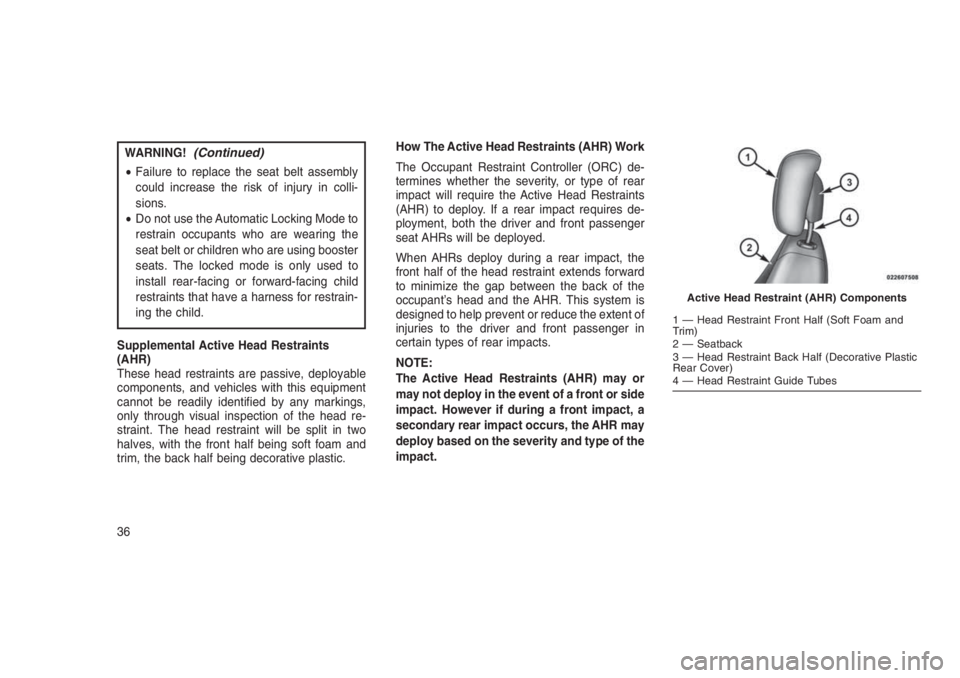
WARNING!(Continued)
•Failure to replace the seat belt assembly
could increase the risk of injury in colli-
sions.
•Do not use the Automatic Locking Mode to
restrain occupants who are wearing the
seat belt or children who are using booster
seats. The locked mode is only used to
install rear-facing or forward-facing child
restraints that have a harness for restrain-
ing the child.
Supplemental Active Head Restraints
(AHR)
These head restraints are passive, deployable
components, and vehicles with this equipment
cannot be readily identified by any markings,
only through visual inspection of the head re-
straint. The head restraint will be split in two
halves, with the front half being soft foam and
trim, the back half being decorative plastic.How The Active Head Restraints (AHR) Work
The Occupant Restraint Controller (ORC) de-
termines whether the severity, or type of rear
impact will require the Active Head Restraints
(AHR) to deploy. If a rear impact requires de-
ployment, both the driver and front passenger
seat AHRs will be deployed.
When AHRs deploy during a rear impact, the
front half of the head restraint extends forward
to minimize the gap between the back of the
occupant’s head and the AHR. This system is
designed to help prevent or reduce the extent of
injuries to the driver and front passenger in
certain types of rear impacts.
NOTE:
The Active Head Restraints (AHR) may or
may not deploy in the event of a front or side
impact. However if during a front impact, a
secondary rear impact occurs, the AHR may
deploy based on the severity and type of the
impact.
Active Head Restraint (AHR) Components
1 — Head Restraint Front Half (Soft Foam and
Trim)
2 — Seatback
3 — Head Restraint Back Half (Decorative Plastic
Rear Cover)
4 — Head Restraint Guide Tubes
36